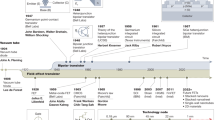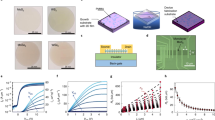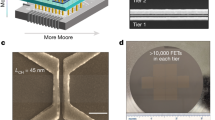Abstract
For more than four decades, transistors have been shrinking exponentially in size, and therefore the number of transistors in a single microelectronic chip has been increasing exponentially. Such an increase in packing density was made possible by continually shrinking the metal–oxide–semiconductor field-effect transistor (MOSFET). In the current generation of transistors, the transistor dimensions have shrunk to such an extent that the electrical characteristics of the device can be markedly degraded, making it unlikely that the exponential decrease in transistor size can continue. Recently, however, a new generation of MOSFETs, called multigate transistors, has emerged, and this multigate geometry will allow the continuing enhancement of computer performance into the next decade.
This is a preview of subscription content, access via your institution
Access options
Subscribe to this journal
Receive 51 print issues and online access
$199.00 per year
only $3.90 per issue
Buy this article
- Purchase on Springer Link
- Instant access to full article PDF
Prices may be subject to local taxes which are calculated during checkout








Similar content being viewed by others
References
Armstrong, G. A., Davis, J. R. & Doyle A. Characterization of bipolar snapback and breakdown voltage in thin-film SOI transistors by two-dimensional simulation. IEEE Trans. Electron Devices 38, 328–336 (1991).
Moselund, K. E. et al. Punch-through impact ionization MOSFET (PIMOS): from device principle to applications. Solid State Electron. 52, 1336–1344 (2008).
Zhang, Q., Zhao, W. & Seabaugh, A. Low-subthreshold-swing tunnel transistors. IEEE Electron Device Lett. 27, 297–300 (2006).
Afzalian, A., Colinge, J. P. & Flandre, D. Physics of gate modulated resonant tunneling (RT)-FETs: multi-barrier MOSFET for steep slope and high on-current. Solid State Electron. 59, 50–61 (2011).
Salahuddin, S. & Datta, S. Use of negative capacitance to provide voltage amplification for low power nanoscale devices. Nano Lett. 8, 405–410 (2008).
Moore, G. E. Cramming more components onto integrated circuits. Electronics 8, 114–117 (1965).
Dennard, R. H. et al. Design of ion-implanted MOSFET's with very small physical dimensions. IEEE J. Solid-State Circuits 9, 256–268 (1974).
Skotnicki, T. & Boeuf, T. How can high-mobility channel materials boost or degrade performance in advanced CMOS. Symp. VLSI Technol. 153–154 (IEEE, 2010).
Engström, O. et al. in Nanoscale CMOS: Innovative Materials, Modeling and Characterization (ed. Balestra, F.) Ch. 2 (Wiley-ISTE, 2010).
Grove, A. S. Physics and Technology of Semiconductor Devices Ch. 11 (Wiley, 1967).
Colinge, J. P. Multiple-gate SOI MOSFETs. Solid State Electron. 48, 897–905 (2004). This technical review paper provides a detailed comparison of the efficiency of channel control by the gate with single-gate, double-gate, tri-gate and gate-all-around configurations, and it introduces the concept of natural length and shows its relationship to short-channel effects.
Skotnicki, T. et al. Innovative materials, devices, and CMOS technologies for low-power mobile multimedia. IEEE Trans. Electron Devices 55, 96–130 (2008).
Sekigawa, T. & Hayashi, Y. Calculated threshold-voltage characteristics of an XMOS transistor having an additional bottom gate. Solid State Electron. 27, 827–828 (1984).
Hisamoto, D., Kaga, T., Kawamoto, Y. & Takeda, E. A fully depleted lean-channel transistor (DELTA): a novel vertical ultra thin SOI MOSFET. Tech. Digest IEEE Electron Devices Meet. 833–836 (IEEE, 1989). The DELTA transistor was the first multigate transistor, and dynamic random access memory cells based on DELTA devices were reported two years later.
Huang, X. et al. Sub 50-nm FinFET: PMOS. Tech. Digest IEEE Electron Devices Meet. 67–70 (IEEE, 1999).
Baie, X., Colinge, J. P., Bayot, V. & Grivei, E. Quantum-wire effects in thin and narrow SOI MOSFETs. IEEE Int. SOI Conf. Proc. 66–67 (IEEE, 1995).
Doyle, B. S. et al. High performance fully-depleted tri-gate CMOS transistors. IEEE Electron Device Lett. 24, 263–265 (2003).
Park, J. T., Colinge, J. P. & Diaz, C. H. Pi-gate SOI MOSFET. IEEE Electron Device Lett. 22, 405–406 (2001).
Yang, F. L. et al. 25 nm CMOS omega FETs. Tech. Digest IEEE Electron Devices Meet. 255–258 (IEEE, 2002).
Colinge, J. P., Gao, M. H., Romano, A., Maes, H. & Claeys C. Silicon-on-insulator 'gate-all-around device'. Tech. Digest IEEE Electron Devices Meet. 595–598 (IEEE, 1990).
Colinge, J. P. et al. Nanowire transistors without junctions. Nature Nanotechnol. 5, 225–229 (2010).
Ansari, L., Feldman, B., Fagas, G., Colinge, J. P. & Greer, J. C. Simulation of junctionless Si nanowire transistors with 3 nm gate length. Appl. Phys. Lett. 97, 062105 (2010).
Hofmann, F. et al. NVM based on FinFET device structures. Solid State Electron. 49, 1799–1804 (2005).
Tang, X. et al. Self-aligned SOI nano flash memory device. Solid State Electron. 44, 2259–2264 (2000).
Suk, S. D. et al. Characteristics of sub 5nm tri-gate nanowire MOSFETs with single and poly Si channels in SOI structure. Symp. VLSI Technol. 142–143 (IEEE, 2009).
Park, J. T., Colinge, C. A. & Colinge, J. P. Comparison of gate structures for short-channel SOI MOSFETs. IEEE Int. SOI Conf. 115–116 (IEEE, 2001).
Kuhn, K. J. CMOS transistor scaling past 32nm and implications on variation. IEEE/SEMI Advanced Semicond. Manuf. Conf. 241–246 (IEEE, 2010).
Okano, K. et al. Process integration technology and device characteristics of CMOS FinFET on bulk silicon substrate with sub-10nm fin width and 20nm gate length. Tech. Digest IEEE Electron Devices Meet. 725–728 (IEEE, 2005).
Cho, H. J. et al. Fin width scaling criteria of body-tied FinFET in sub-50 nm regime. Conf. Digest Device Res. Conf. 209–210 (IEEE, 2004).
Kanemura, T., Izumida, T., Aoki, N. & Kondo, M. Improvement of drive current in bulk-FinFET using full 3D process/device simulations. Int. Conf. Simulation Semicond. Processes Devices 131–134 (IEEE, 2006).
Cao, S., Chun, J. H., Salman, A. A., Beebe, S. G. & Dutton, R. W. Gate-controlled field-effect diodes and silicon-controlled rectifier for charged-device model ESD protection in advanced SOI technology. Microelectron. Reliab. 51, 756–764 (2011).
Thijs, S. et al. Advanced ESD power clamp design for SOI FinFET CMOS technology. Int. Conf. IC Design Technol. 43–46 (IEEE, 2010).
Subramanian, V. et al. Planar bulk MOSFETs versus FinFETs: an analog/RF perspective. IEEE Trans. Electron Devices 12, 3071–3079 (2006).
Yan, R. H., Ourmazd, A. & Lee, K. F. Scaling the Si MOSFET: from bulk to SOI to bulk. IEEE Trans. Electron Devices 39, 1704–1710 (1992).
Lee, C. W. et al. Device design guidelines for nano-scale MuGFETs. Solid State Electron. 51, 505–510 (2007).
Colinge, J. P. in FinFETs and Other Multi-Gate Transistors (ed. Colinge, J. P.) 1–48 (Springer, 2007).
Kavalieros, J. et al. Tri-gate transistor architecture with high-κ gate dielectrics, metal gates and strain engineering. Digest Tech. Papers Symp. VLSI Technol. 50–51 (IEEE, 2006).
Yeh, C.-C. et al. A low operating power FinFET transistor module featuring scaled gate stack and strain engineering for 32/28nm SoC technology. IEEE Electron Devices Meet. 772–775 (IEEE, 2011).
Joshi, R. V. et al. FinFET SRAM for high-performance low-power applications. Proc. 34th Eur. Solid-State Device Res. Conf. 69–72 (IEEE, 2004).
Basker, V. et al. A 0.063 μm2 FinFET SRAM cell demonstration with conventional lithography using a novel integration scheme with aggressively scaled fin and gate pitch. Symp. VLSI Technol. 19–20 (IEEE, 2010).
Guillorn, M. A. et al. A 0.021 μm2 trigate SRAM cell with aggressively scaled gate and contact pitch. Symp. VLSI Technol. 64–65 (IEEE, 2011).
Wu, C. C. et al. High performance 22/20nm FinFET CMOS devices with advanced high-K/metal gate scheme. IEEE Electron Devices Meet. 600–603 (IEEE, 2011).
ITRS International Technology Working Groups. ITRS 2010 update. International Road Map for Semiconductors 〈http://www.itrs.net/Links/2010ITRS/2010Update/ToPost/2010Tables_ORTC_ITRS.xls〉 (2010).
Acknowledgements
This work was supported by Science Foundation Ireland grants 05/IN/I888, 07/IN.1/I937 and 10/IN.1/I2992, the European project SQWIRE under Grant Agreement No. 257111 and the European Community (EC) Seventh Framework Program through the Network of Excellence Nano-TEC under Contract 257964. We thank N. Petkov and M. Schmidt for the electron microscopy images in Fig. 6.
Author information
Authors and Affiliations
Corresponding author
Ethics declarations
Competing interests
The authors declare no competing financial interests.
Additional information
Reprints and permissions information is available at http://www.nature.com/reprints.
Rights and permissions
About this article
Cite this article
Ferain, I., Colinge, C. & Colinge, JP. Multigate transistors as the future of classical metal–oxide–semiconductor field-effect transistors. Nature 479, 310–316 (2011). https://doi.org/10.1038/nature10676
Published:
Issue Date:
DOI: https://doi.org/10.1038/nature10676
This article is cited by
-
Real-space observation of a two-dimensional electron gas at semiconductor heterointerfaces
Nature Nanotechnology (2023)
-
The understanding of the impact of efficiently optimized underlap length on analog/RF performance parameters of GNR-FETs
Scientific Reports (2023)
-
Encapsulated carbon nanotube array as a thermal interface material compatible with standard electronics packaging
Nano Research (2023)
-
A Quantitative Comparison Between the Electrical Characteristics of Vertical Super Thin Body (VSTB) FET and Silicon on Insulator Vertical Super-Thin Body (SOI VSTB) FET
Silicon (2023)
-
Ion-gated tungsten oxide based electrochemical transistors with subthreshold slopes approaching the thermodynamic limit
Applied Physics A (2023)
Comments
By submitting a comment you agree to abide by our Terms and Community Guidelines. If you find something abusive or that does not comply with our terms or guidelines please flag it as inappropriate.



